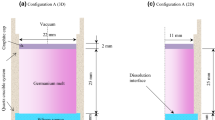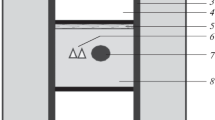Abstract
In this paper we consider crystallization of solid solutions and formation of growth zoning in minerals. To ascertain the role of various mechanisms producing zoning we have constructed kinetic models of nonsteady solid solution crystal growth. The equations obtained describe the temporal evolution of the solute and crystal composition. Since these equations are not solvable analytically we have solved them numerically by a fourth-order Runge–Kutta method. On the basis of this solution we can compute the zoning profiles for different crystallization modes and conditions. The constructed models have been used for study of mechanisms of zoning formation in metamorphic garnets. We conclude that the main mechanism of production of growth zoning is fractionation. The role of change of distribution coefficient in “equilibrium crystallization” is negligible. The modelling of zoning profiles reveals that simple arc-shaped profiles originate from crystallization in a closed system while complicated nonmonotonic profiles appear with crystallization in open systems under fluid flow. The duration of metamorphic garnet crystallization is estimated.
Similar content being viewed by others
REFRENCES
Azimov, P., 2000, Growth zoning formation in metamorphic garnets (the role of the P-T conditions and fluid regime): PhD Thesis (unpublished), Institute of Precambrian Geology and Geochronology, St.-Petersburg, 232p. (In Russian)
Azimov, P. Ya., and Shtukenberg, A. G., 2000, Simulation of phase diagrams for water-salt systems with solid solutions: Russ. J. Inorg. Chem., v.45, no.8, p. 1302-1309.
Azimov, P., and Shtukenberg, A., 2001, The thermodynamic analysis of factors, determining growth zoning in metamorphic garnets: Dokl. Earth Sci., v.376, no.1, p. 79.
Berman, R. G., and Aranovich, L. Ya., 1996, Optimized standard state and mixing properties of minerals: I. Model calibration for olivine, orthopyroxene, cordierite, garnet, and ilmenite in the system FeO-MgO-CaO-Al2O3-TiO2-SiO2: Contrib. Mineral Petrol., v.126, no.1, p. 1-24.
Chakraborty, S., and Ganguly, J., 1991, Compositional zoning and cation diffusion in garnets. in Diffusion, atomic ordering and mass transport: Selected topics in geochemistry: Springer-Verlag, New York, Ganguly, J., ed. p. 120-175. (Adv. Phys. Geochem., v. 8)
Chernov, A. A., 1984, Modern crystallography: III. Crystal Growth, (with contributions by E. I. Givargizov, K. S. Bagdasarov, V. A. Kuznetsov, L. N. Demianets, and A. N. Lobachev) Springer Series in Solid-State Science, Vol. 36 Springer-Verlag, New York, 518p.
Doerner, H., and Haskins, W. M., 1925, Co-precipitation of radium and barium sulfates: J. Am. Chem. Soc., v.47, no.3, p. 662-675.
Drugova, G. M., Nikitin, Yu. V., and Terent'eva, M. V., 1970, Zonal garnets of the Shueretskoye deposits: Int. Geol. Rev., v.12, p. 1436-1440.
Grichuck, D. V., 1996, The ore elements in a hydrothermal system of a mid-oceanic ridge: Geochemistry, no.7, p. 650-672. (In Russian)
Henderson, L. M., and Kracek, F. C., 1927, The fractional precipitation of barium and radium chromates: J. Am. Chem. Soc., v.49, no.3, p. 738-749.
Hollister, L. S., 1966, Garnet zoning: An interpretation based on the Rayleigh fractionation model: Science, v.154, no.3757, p. 1647-1651.
Johnson, J. W., Oelkers, E. H., and Helgeson, H. C., 1992, SUPCRT92: A software package for calculating the standard molal thermodynamic properties of minerals, gases, aqueous species, and reactions from 1 to 5000 bars and 0 to 1000°C: Comp. Geosci., v.18, no.7, p. 899-947.
Perchuk, L. L., 1977, Thermodynamic control of metamorphic processes, in Saxena, S. K., and Bhattacharji, S., eds. Energetics of geological processes. Springer-Verlag, New York, p. 275-352.
Rubie, D. C., 1986, The catalysis of mineral reactions by water and restrictions on the presence of aqueous fluid during metamorphism: Miner. Mag., v.50, no.3, p. 399-415.
Shock, E. L., and Helgeson, H. C., 1988, Calculation of the thermodynamic and transport properties of aqueous species at high pressures and temperatures: Correlation algorithms for ionic species and equation of state predictions to 5 kb and 1000°C: Geochim. Cosmochim. Acta, v.52, no.8, p. 2009-2036.
Skvirsky, A. L., 1995, New thermodynamic approach to simulating the water-rock interaction: The “FLUID” modeling code, in WRI-8 Proceedings, Vladivostok, Russia, 23–27 August 1995.
Soloviev, V., Shtukenberg, A., Punin, Yu., and Azimov, P., 1997, Study of mixed crystal growth kinetics, in Proceedings of the 5th ISHR, Gatlinburg, Tennessee, USA, July 1997, p. 267-268.
Spear, F. S., and Selverstone, J., 1983, Quantitative P-T paths from zoned minerals: Theory and tectonic applications: Contrib. Mineral. Petrol., v.83, no.3–4, p. 348-357.
Tanger IV, J. C., and Helgeson, H. C., 1988, Calculation of the thermodynamic and transport properties of aqueous species at high pressures and temperatures: Revised equations of state for standard partial molal properties of ions and electrolytes: Am. J. Sci., v.288, no.1, p. 19-98.
Tracy, R. J., 1982, Compositional zoning and inclusions in metamorphic minerals: Rev. Mineral, v.10, p. 355-397.
Tracy, R. J., Robinson, P., and Thompson, A. B., 1976, Garnet composition and zoning in the determination of temperature and pressure of metamorphism, central Massachusetts: Am. Mineral, v.61, no.7–8, p. 762-775
Walther, J. V., and Wood, B. J., 1984, Rate and mechanism in prograde metamorphism: Contrib. Mineral. Petrol., v.88, no.3, p. 246-259.
Whitney, D. L., and Ghent, E. D., 1993 Prograde reactions and garnet zoning reversals in staurolite schist, British Columbia: Significance for thermobarometric interpretations: J. Metam. Geol., v.11, p. 779-788.
Whitney, D. L., Mechum, T. A., Dilek, Y. R., and Kuehner, S. M., 1996a, Modification of garnet by fluid infiltration during regional metamorphism in garnet through sillimanite-zone rocks, Dutchess County, New York: Am. Mineral., v.81, p. 696-705.
Whitney, D. L., Mechum, T. A., Kuehner, S. M., and Dilek, Y. R., 1996b, Progressive metamorphism of pelitic rocks from protholith to granulite facies, Dutchess County, New York, USA: Constraints on the timing of fluid infiltration during regional metamorphism: J. Metam. Geol., v.14, p. 163-181.
Woodsworth, G. J., 1977, Homogenization of zoned garnets from pelitic schists: Can. Mineral., v.15, no.2, p. 230-242.
Yardley, B. W. D., Rochelle, C. A., Barnicoat, A. C., and Lloyd, G. E., 1991, Oscillatory zoning in metamorphic minerals: An indicator of infiltration metasomatism: Mineral. Mag., v.55, no.3/380, p. 357-366.
Author information
Authors and Affiliations
Rights and permissions
About this article
Cite this article
Azimov, P., Shtukenberg, A. Numerical Modeling of Growth Zoning at Nonstationary Crystallization of Solid Solutions: Metamorphic Garnets. Mathematical Geology 35, 405–430 (2003). https://doi.org/10.1023/A:1024841907133
Issue Date:
DOI: https://doi.org/10.1023/A:1024841907133




